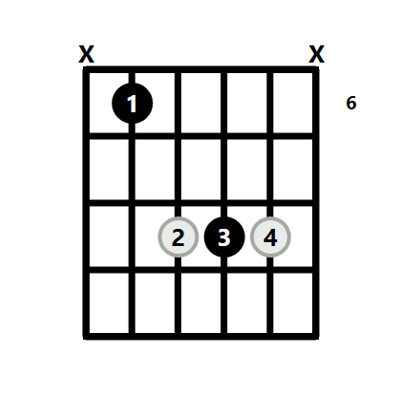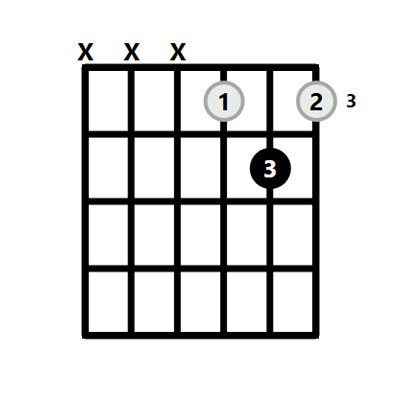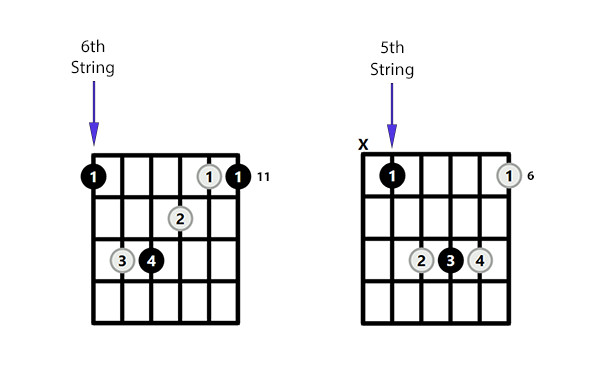The Eb Major chord, often written as Eb, is a foundational chord for guitarists across genres, from pop and rock to jazz and blues. It’s a versatile and rich-sounding chord that, once mastered, will significantly expand your musical vocabulary. This comprehensive guide will take you beyond basic shapes, delving into music theory, various voicings, and practical techniques to truly master the Eb Major Guitar Chord.
Understanding the Eb Major Chord: Music Theory Essentials
Before diving into finger positions, let’s understand what makes up an Eb Major chord. Like all major chords, Eb Major is built upon a triad, consisting of three notes played together. Specifically, the Eb Major chord is composed of:
- Root: Eb (E flat)
- Major Third: G
- Perfect Fifth: Bb (B flat)
These notes are derived from the Eb Major scale, taking the 1st, 3rd, and 5th degrees of the scale. Understanding this theoretical foundation helps you see the chord not just as a shape, but as a collection of harmonically related notes.
Furthermore, the intervals within the Eb Major chord, starting from the root note (Eb), are:
- Major 3rd: The interval between Eb and G.
- Minor 3rd: The interval between G and Bb.
- Perfect 4th: The interval between Bb and Eb (octave root).
Knowing these intervals is beneficial for understanding chord construction and how Eb Major relates to other chords and scales. Notably, Eb Major is the I chord (tonic) in the key of Eb Major, setting the tonal center for songs in this key. The chords in the key of Eb Major are Eb Major, F minor, G minor, Ab Major, Bb Major, C minor, and D diminished.
Exploring 10 Essential Eb Major Chord Shapes
While many guitarists start with a simplified Eb chord, exploring different shapes unlocks new sonic possibilities and improves fretboard fluency. Here are 10 shapes for the Eb Major chord, ranging from beginner-friendly to more advanced voicings:
 Eb Major Chord – 10 Shapes
Eb Major Chord – 10 Shapes
The Standard Eb Major Chord Shape: Root on the 5th String
This is arguably the most common Eb Major chord shape. It’s a movable barre chord shape rooted on the 5th string, often played at the 6th fret to achieve Eb. While technically a barre chord, many players execute it without barring the 6th string, focusing on the root note with the index finger.
 Eb Chord Guitar
Eb Chord Guitar
The Easy Eb Major Chord Shape: Perfect for Beginners
For guitarists new to Eb Major, or those seeking a simpler voicing, the “easy” Eb shape is ideal. This version utilizes just the top three strings and mimics the shape of an open D chord, but shifted up one fret. It’s a fantastic starting point for incorporating Eb into your playing without the challenge of barre chords.
 Easy Eb Chord Guitar
Easy Eb Chord Guitar
Step-by-Step Guide to Playing the Standard Eb Major Chord
Let’s break down the standard Eb Major shape into a step-by-step process, ensuring correct finger placement and technique:
- Index Finger: Place your index finger on the 6th fret of the 5th string (A string).
- Middle Finger: Position your middle finger on the 8th fret of the 4th string (D string).
- Ring Finger: Place your ring finger on the 8th fret of the 3rd string (G string).
- Pinky Finger: Place your pinky finger on the 8th fret of the 2nd string (B string).
- Strumming: Avoid strumming the 6th string (low E) and strum downwards across the top five strings (A, D, G, B, high E).
Following these steps carefully allows you to check your finger positioning and ensure you’re playing the chord accurately. This methodical approach is particularly useful when learning new chord shapes or troubleshooting finger placement issues.
Barre Chord Variations for Eb Major
Barre chords are essential for playing chords all over the neck. Eb Major is readily playable as a barre chord using two common barre shapes:
- Root 6 Barre Chord Shape: Based on the E Major barre chord shape, barre at the 11th fret.
- Root 5 Barre Chord Shape: Based on the A Major barre chord shape, barre at the 6th fret (this is the “standard” shape discussed earlier).
 Eb Barre Chord Guitar
Eb Barre Chord Guitar
Mastering these barre chord shapes gives you flexibility in voicing and transitioning between chords across the fretboard.
Eb Major Triads: Inversions and Voicings
Beyond full chord shapes, exploring Eb Major triads – three-note chords – opens up even more musical options. Triads are particularly useful in lead guitar playing, chord melody arrangements, and creating lighter, more open chord voicings. The three inversions of the Eb Major triad are:
- Root Position: Eb – G – Bb
- 1st Inversion: G – Bb – Eb
- 2nd Inversion: Bb – Eb – G
Here are six different ways to play Eb Major triads across the fretboard, incorporating these inversions:
 Eb Major Triad Guitar
Eb Major Triad Guitar
Experimenting with triads enhances your understanding of chord construction and provides valuable tools for arranging and improvising.
Eb Major Chord in Different Keys
Understanding the harmonic context of the Eb Major chord involves knowing which musical keys it naturally appears in. Eb Major is a diatonic chord (naturally occurring) in several keys:
- Eb Major: As the tonic (I chord). (Eb, Fm, Gm, Ab, Bb, Cm, Ddim)
- Bb Major: As the IV chord (subdominant). (Bb, Cm, Dm, Eb, F, Gm, Adim)
- Ab Major: As the V chord (dominant). (Ab, Bbm, Cm, Db, Eb, Fm, Gdim)
- C minor: As the III chord (relative major’s minor). (Cm, Ddim, Eb, Fm, Gm, Ab, Bb)
- G minor: As the VI chord (relative minor). (Gm, Adim, Bb, Cm, Dm, Eb, F)
- F minor: As the VII chord (minor key dominant’s relative minor). (Fm, Gdim, Ab, Bbm, Cm, Db, Eb)
Recognizing these key relationships helps you understand how Eb Major functions within chord progressions and song structures.
Alternative and Substitute Eb Major Chords
While the standard Eb Major shapes are essential, exploring alternative voicings and substitutions adds color and depth to your playing. Some useful alternatives include:
- Higher Position Voicings: Shapes played higher up the neck, offering different tonal qualities.
- Open String Voicings: Less common for Eb Major, but possible in altered tunings or with capos.
Furthermore, Eb Major can often be substituted by related chords to create interesting harmonic variations:
- Eb sus4: Adds a suspended 4th, creating a softer, unresolved sound.
- Eb sus2: Suspends the 2nd, offering a brighter, more open quality.
- Eb add9: Adds a 9th, creating a richer, more complex sound.
Conversely, Eb Major itself can often act as a simpler substitute for more complex chords like Eb Major 7, Eb7, and other extended Eb chords (though not for minor chords).
Scales to Play Over the Eb Major Chord
For soloing and improvisation over an Eb Major chord, certain scales are particularly effective:
- Eb Major Scale: The most fundamental choice, providing a consonant and melodic sound.
- Eb Major Pentatonic Scale: A simplified version of the major scale, great for blues and rock-influenced solos.
- Eb Lydian Mode: A major scale mode with a raised 4th, creating a brighter, more ethereal sound.
Experimenting with these scales will help you create melodies and improvisations that complement the Eb Major chord.
Further Exploration
Mastering the Eb Major chord is an ongoing journey. Continue to explore different shapes, voicings, and theoretical concepts to deepen your understanding and expand your guitar skills. Resources like chord dictionaries, online lessons, and ear training exercises can further enhance your musical development.
[
